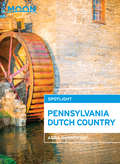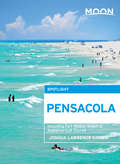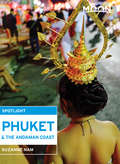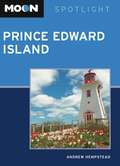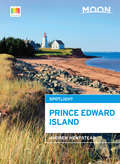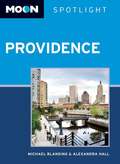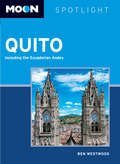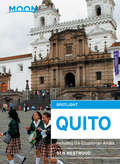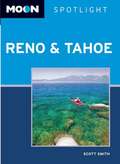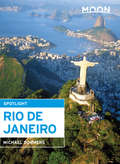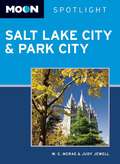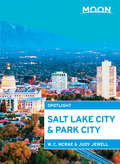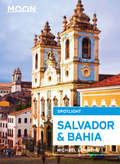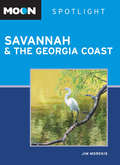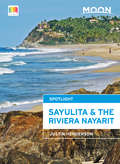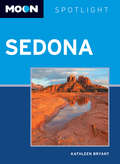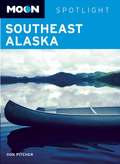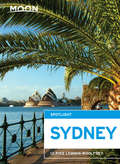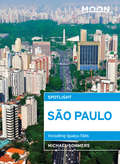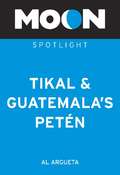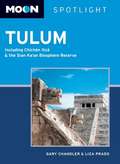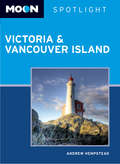- Table View
- List View
Moon Spotlight Pennsylvania Dutch Country: 2014
by Anna DubrovskyMoon Spotlight Pennsylvania Dutch Country is a 130-page compact guide covering Lancaster County, Gettysburg, Hershey, Harrisburg, and other highlights of south-central Pennsylvania, notable for its large Amish and Mennonite populations. Author Anna Dubrovsky offers her seasoned advice on must-see attractions, and includes maps with sightseeing highlights so you can make the most of your time. This lightweight guide is packed with recommendations on sights, entertainment, shopping, recreations, accommodations, food, and transportation, as well as easy-to-read maps, making navigating this interesting region of the Keystone State uncomplicated and enjoyable.This Spotlight guidebook is excerpted from Moon Pennsylvania.
Moon Spotlight Pensacola
by Joshua Lawrence KinserMoon Spotlight Pensacola is a 90-page compact guide covering this picture-perfect beach retreat. Author Joshua Kinser offers his seasoned advice on must-see attractions, and includes maps with sightseeing highlights so you can make the most of your time. This lightweight guide is packed with recommendations on sights, entertainment, shopping, recreation, accommodations, food, and transportation, as well as easy-to-read maps, making navigating this laid-back, cultural paradise uncomplicated and enjoyable.This Spotlight guidebook is excerpted from Moon Florida Gulf Coast.
Moon Spotlight Phuket & the Andaman Coast
by Suzanne NamMoon Spotlight Phuket & the Andaman Coast is a 70-page compact guide covering this gorgeous southeast Asian city and stunning stretch of shoreline. Author Suzanne Nam offers her seasoned advice on must-see attractions, and includes maps with sightseeing highlights so you can make the most of your time. This lightweight guide is packed with recommendations on sights, entertainment, shopping, recreation, accommodations, food, and transportation, making navigating this bustling city and lush landscape uncomplicated and enjoyable.This full-color Spotlight guidebook is excerpted from Moon Phuket & Ko Samui and includes vibrant photos and helpful maps.
Moon Spotlight Prince Edward Island: 2012
by Andrew HempsteadMoon Spotlight Prince Edward Islandis a 60-page compact guide covering the best of Canada's smallest province, including Charlottetown, Queens County, Prince County, and Cavendish. Travel writer and photographer Andrew Hempstead offers his firsthand advice on what sights are must-sees, and sightseeing highlight maps make planning your time easy. This lightweight guide is packed with recommendations on sights, entertainment, shopping, recreation, accommodations, food, and transportation. Helpful maps guide travelers through this cultivated Canadian locale. This Spotlight guidebook is excerpted fromMoon Atlantic Canada.
Moon Spotlight Prince Edward Island: 2015
by Andrew HempsteadMoon Spotlight Prince Edward Island is a 60-page compact guide covering the best of "the birthplace of Canada," including Charlottetown, Queens County, Prince County, and Cavendish. Travel writer and photographer Andrew Hempstead offers his firsthand advice on must-see attractions, as well as maps with sightseeing highlights, so you can make the most of your time. This lightweight guide is packed with recommendations on entertainment, shopping, recreations, accommodations, food, and transportation, making navigating Canada's smallest, greenest province uncomplicated and enjoyable.This full-color Spotlight guidebook is excerpted from Moon Atlantic Canada.
Moon Spotlight Providence
by Michael Blanding Alexandra HallMoon Spotlight Providence is a 70-page compact guide covering the best of Providence, including Waterplace Park and Riverwalk, Kennedy Plaza, Jackson-Gardner Park, and the Cranston Street Armory. Authors Michael Blanding and Alexandra Hall offer their seasoned advice on must-see attractions, and include maps with sightseeing highlights so you can make the most of your time. This lightweight guide is packed with recommendations on entertainment, shopping, recreations, accommodations, food, and transportation, making navigating Rhode Island's capital city uncomplicated and enjoyable.
Moon Spotlight Quito: 2013
by Ben WestwoodMoon Spotlight Quito is a 115-page compact guide covering Ecuador's capital city and highlights of the surrounding Andes. Seasoned traveler and journalist Ben Westwood offers his firsthand advice on must-see attractions, as well as maps with sightseeing highlights, so you can make the most of your time. This lightweight guide is packed with recommendations on entertainment, shopping, recreation, hotels, food, and transportation, making navigating this diverse area uncomplicated and enjoyable.This Spotlight guidebook is excerpted from Moon Ecuador. This ebook and its features are best experienced on iOS or Android devices and the Kindle Fire.
Moon Spotlight Quito: 2014
by Ben WestwoodMoon Spotlight Quito is a 115-page compact guide covering Ecuador's capital city and highlights of the surrounding Andes. Seasoned traveler and journalist Ben Westwood offers his firsthand advice on must-see attractions, as well as maps with sightseeing highlights, so you can make the most of your time. This lightweight guide is packed with recommendations on entertainment, shopping, recreation, hotels, food, and transportation, making navigating this diverse area uncomplicated and enjoyable.This Spotlight guidebook is excerpted from Moon Ecuador & the Galápagos Islands.
Moon Spotlight Reno & Tahoe
by Scott SmithMoon Spotlight Reno & Tahoe is a 110-page compact guide covering the best of Reno and Lake Tahoe, including Peppermill Casino, Riverfront Plaza, the Tahoe Rim Trail, and Diamond Peak. Author Scott Smith offers his seasoned advice on must-see attractions, and includes maps with sightseeing highlights so you can make the most of your time. This lightweight guide is packed with recommendations on entertainment, shopping, recreations, accommodations, food, and transportation, making navigating these two night-and-day destinations uncomplicated and enjoyable.
Moon Spotlight Rio de Janeiro
by Michael SommersMoon Spotlight Rio de Janeiro is a 100-page compact guide to the colorful squares, sultry nightlife, and fabulous white sand beaches of this Brazilian metropolis and surrounding areas. Author Michael Sommers offers his seasoned advice on must-see attractions, and includes maps with sightseeing highlights so you can make the most of your time. This lightweight guide is packed with recommendations on sights, entertainment, shopping, recreation, accommodations, food, and transportation, making navigating this tropical treasure uncomplicated and enjoyable.This full-color Spotlight guidebook is excerpted from Moon Brazil.
Moon Spotlight Salt Lake City & Park City: 2011
by W. C. Mcrae Judy JewellMoon Spotlight Salt Lake City and Park City is a 90-page compact guide covering the best of Salt Lake City and Park City, including Temple Square, Red Butte Garden and Arboretum, Snowbird Ski and Summer Resort, and Wasatch Mountain State Park. Authors W. C. McRae and Judy Jewell offer seasoned advice on must-see attractions, and includes maps with sightseeing highlights so you can make the most of your time. This lightweight guide is packed with recommendations on entertainment, shopping, recreation, accommodations, food, and transportation, making navigating these appealing destinations uncomplicated and enjoyable.
Moon Spotlight Salt Lake City & Park City: 2015
by W. C. Mcrae Judy JewellMoon Spotlight Salt Lake City & Park City is a 90-page compact guide covering the best of Salt Lake City and Park City, including Temple Square, Red Butte Garden and Arboretum, Snowbird Ski and Summer Resort, and Wasatch Mountain State Park. Authors W. C. McRae and Judy Jewell offer seasoned advice on must-see attractions, and includes maps with sightseeing highlights so you can make the most of your time. This lightweight guide is packed with recommendations on sights, entertainment, shopping, recreation, accommodations, food, and transportation, as well as easy-to-read maps, making navigating these appealing destinations uncomplicated and enjoyable.This Spotlight guidebook is excerpted from Moon Utah.
Moon Spotlight Salvador & Bahia
by Michael SommersMoon Spotlight Salvador & Bahia is an 85-page compact guide to the best of Salvador and Bahia. Brazil resident and magazine correspondent Michael Sommers offers his firsthand advice on what sights are must-sees, and sightseeing highlights maps make planning your time easy. This lightweight guide is packed with recommendations on entertainment, shopping, recreation, accommodations, food, and transportation, making navigating these two historic highlights of Brazil uncomplicated and enjoyable.
Moon Spotlight Savannah & the Georgia Coast: 2011
by Jim MorekisMoon Spotlight Savannah and the Georgia Coastis a 145-page compact guide covering historic Savannah and the Golden Isles, including Brunswick and Glynn County, Jekyll Island, St. Simon's Island, Darien and McIntosh County, Cumberland Island, St. Mary's, and the Okefenokee Swamp. Author Jim Morekis offers seasoned advice on must-see attractions, and includes maps with sightseeing highlights so you can make the most of your time. This lightweight guide is packed with recommendations on sights, entertainment, shopping, recreations, accommodations, food, and transportation, as well as easy-to-read maps, making navigating these historic areas uncomplicated and enjoyable.
Moon Spotlight Savannah & the Georgia Coast: 2012
by Jim MorekisMoon Spotlight Savannah and the Georgia Coast is a 145-page compact guide covering historic Savannah and the Golden Isles, including Brunswick and Glynn County, Jekyll Island, St. Simon's Island, Darien and McIntosh County, Cumberland Island, St. Mary's, and the Okefenokee Swamp. Author Jim Morekis offers seasoned advice on must-see attractions, and includes maps with sightseeing highlights so you can make the most of your time. This lightweight guide is packed with recommendations on entertainment, shopping, recreations, accommodations, food, and transportation, making navigating these historic areas uncomplicated and enjoyable.
Moon Spotlight Sayulita & the Riviera Nayarit
by Justin HendersonMoon Spotlight Sayulita & the Riviera Nayarit is a 70-page compact guide covering Sayulita and the best of the Riviera Nayarit, including Rinón de Guayabitos, La Peñita, San Blas, and Tepic. Author Justin Henderson provides his firsthand advice on must-see attractions, as well as maps with sightseeing highlights, so you can make the most of your time. This lightweight guide is packed with recommendations on entertainment, shopping, recreation, hotels, food, and transportation, making navigating Mexico's Pacific shore uncomplicated and enjoyable.This full-color Spotlight guidebook is excerpted from Moon Puerto Vallarta.
Moon Spotlight Sedona
by Kathleen BryantMoon Spotlight Sedona is a 60-page compact guide covering the best of this red rock city. Sedona resident Kathleen Bryant offers her firsthand advice on must-see attractions, as well as maps with sightseeing highlights, so you can make the most of your time. This lightweight guide is packed with recommendations on entertainment, shopping, recreation, hotels, food, and transportation, making navigating the beautiful area of Sedona uncomplicated and enjoyable.This Spotlight guidebook is excerpted from Moon Phoenix, Scottsdale & Sedona. This ebook and its features are best experienced on iOS or Android devices and the Kindle Fire.
Moon Spotlight Shanghai
by Susie GordonMoon Spotlight Shanghaiis an 120-page compact guide covering the city of Shanghai, as well as surrounding areas. Author Susie Gordon offers her seasoned advice on must-see attractions, and includes maps with sightseeing highlights so you can make the most of your time. This lightweight guide is packed with recommendations on sights, entertainment, shopping, recreations, accommodations, food, and transportation, as well as easy-to-read maps, making navigating this bold, bright metropolis uncomplicated and enjoyable.
Moon Spotlight Sonoma Valley
by Philip GoldsmithMoon Spotlight Sonoma Valley is a 125-page compact guide covering California's Southern and Northern Sonoma region. Author Philip Goldsmith offers his seasoned advice on what sights are must-sees and includes maps with sightseeing highlights so planning your time is easy. This lightweight guide is packed with recommendations on entertainment, shopping, recreations, accommodations, food, and transportation, making navigating this idyllic region uncomplicated and enjoyable.
Moon Spotlight Southeast Alaska
by Don PitcherMoon Spotlight Southeast Alaska is a 144-page compact guide covering Southeast Alaska's highlights, including Ketchikan, Prince of Wales Island, Juneau, Glacier Bay National Park, and Skagway. Author Don Pitcher offers his firsthand advice on what sights are must-sees, and sightseeing highlights maps make planning your time easy. This lightweight guide is packed with recommendations on entertainment, shopping, recreation, accommodations, food, and transportation, making navigating the Alaska Panhandle uncomplicated and enjoyable.
Moon Spotlight Sydney
by Ulrike Lemmin-WoolfreyMoon Spotlight Sydney is a full-color, 80-page compact guide covering the city of Sydney, as well as surrounding areas. Author Ulrike Lemmin-Woolfrey offers her seasoned advice on must-see attractions, and she includes maps with sightseeing highlights so you can make the most of your time. This lightweight guide is packed with recommendations on entertainment, shopping, recreation, accommodations, food, and transportation, making navigating this iconic city uncomplicated and enjoyable.This Spotlight guidebook is excerpted from Moon Sydney & the Great Barrier Reef.
Moon Spotlight São Paulo
by Michael SommersMoon Spotlight São Paulo is a 70-page compact guide to the best of São Paulo. Brazil resident and magazine correspondent Michael Sommers offers his firsthand advice on what sights are must-sees, and sightseeing highlights maps make planning your time easy. This lightweight guide is packed with recommendations on entertainment, shopping, recreation, accommodations, food, and transportation, making navigating this bustling city uncomplicated and enjoyable.
Moon Spotlight Tikal and Guatemala's Petén
by Al ArguetaMoon Spotlight Tikal & Guatemala's Petén is a 60-page compact guide covering Tikal, the best-known Mayan ruins, and Guatemala's lowland jungle region. Author Al Argueta offers his seasoned advice on what sights are must-sees and includes maps with sightseeing highlights so planning your time is easy. This lightweight guide is packed with recommendations on sights, entertainment, shopping, recreations, accommodations, food, and transportation. Helpful maps make navigating this adventure-filled area uncomplicated.This Spotlight guidebook is excerpted from Moon Guatemala.
Moon Spotlight Tulum
by Gary Chandler Liza PradoMoon Spotlight Tulumis an 86-page compact guide covering Tulum, southern Quintana Roo, Chichén Itzá,and the Sian Ka’an Biosphere Reserve. Authors Gary Chandler and Liza Prado offer their seasoned advice on must-see attractions, and they include maps with sightseeing highlights so you can make the most of your time. This lightweight guide is packed with recommendations on sights, entertainment, shopping, recreation, accommodations, food, and transportation, as well as easy-to-read maps, making navigating these fascinating destinations uncomplicated and enjoyable.
Moon Spotlight Victoria & Vancouver Island
by Andrew HempsteadMoon Spotlight Victoria & Vancouver Island is a 100-page compact guide covering Victoria and Vancouver Island, including the Vicinity of Victoria, Southern Gulf Islands, Nanaimo and Vicinity, Highway 4 to the West Coast, Tofino, Oceanside, Comox Valley, and Northern Vancouver Island. Author Andrew Hempstead offers seasoned advice on must-see attractions and activities, and sightseeing highlight maps make planning your time easy. This lightweight guide is packed with recommendations on entertainment, shopping, recreation, accommodations, food, and transportation, making navigating this popular northern getaway uncomplicated and enjoyable.
